A County Town in Ruins: Memories, Emotions, and Sense of Place in Post-Earthquake Beichuan, China
Abstract
1. Introduction: The Meanings and Senses of Ruins
2. Literature Review: Post-Disaster Memories, Emotions, and Sense of Place
2.1. Memories and Emotions
2.2. Sense of Place
3. Methodology
3.1. Study Site and Post-Earthquake Landscape
3.2. Method
4. Ruins Aroused Memories
4.1. Daily Life Memories
4.2. Earthquake Memories
5. Ruins Aroused Emotions
5.1. Traumatic Emotions
5.2. Nostalgic Emotions
6. Sense of Place towards the Ruined County Town
6.1. Place Identity
6.2. Place Attachment
6.3. Place Behaviours
7. Conclusions
Author Contributions
Funding
Institutional Review Board Statement
Informed Consent Statement
Data Availability Statement
Conflicts of Interest
References
- Dunford, M.; Li, L. Earthquake reconstruction in Wenchuan: Assessing the state overall plan and addressing the ‘forgotten phase’. Appl. Geogr. 2011, 31, 998–1009. [Google Scholar] [CrossRef]
- Qian, L.; Zhang, J.; Zhang, H.; Zheng, C. Hit close to home: The moderating effects of past experiences on tourists’ on-site experiences and behavioral intention in post-earthquake site. Asia Pac. J. Tour. Res. 2017, 22, 936–950. [Google Scholar] [CrossRef]
- Marschall, S. Touring memories of the erased city: Memory, tourism and notions of ‘home’. Tour. Geogr. 2015, 17, 332–349. [Google Scholar] [CrossRef]
- Trigg, D. The place of trauma: Memory, hauntings, and the temporality of ruins. Mem. Stud. 2009, 2, 87–101. [Google Scholar] [CrossRef]
- DeSilvey, C.; Edensor, T. Reckoning with ruins. Prog. Hum. Geogr. 2013, 37, 465–485. [Google Scholar] [CrossRef]
- Garrett, B. Book review. Ruins of Modernity by Julia Hell & Andreas Schonle. Environ. Plan. D Soc. Space 2011, 29, 378–380. [Google Scholar]
- Pred, A. Place as historically contingent process: Structuration and the time-geography of becoming places. Ann. Assoc. Am. Geogr. 1984, 74, 279–297. [Google Scholar] [CrossRef]
- Lucas, G. Modern ruins. In Oxford Handbook of the Archaeology of the Contemporary Past; Graves-Brown, P., Harrison, R., Piccini, A., Eds.; Oxford University Press: Oxford, UK, 2013. [Google Scholar]
- Osborne, B.S. Landscapes, memory, monuments, and commemoration: Putting identity in its place. Can. Ethn. Stud. 2001, 33, 39. [Google Scholar]
- Hoelscher, S.; Alderman, D. Memory and place: Geographies of a critical relationship. Soc. Cult. Geogr. 2004, 5, 347–355. [Google Scholar] [CrossRef]
- Nora, P. Between memory and history: Les lieux de mémoire. Representations 1989, 26, 7–24. [Google Scholar] [CrossRef]
- Butler, A.; Knez, I.; Åkerskog, A.; Herlin, I.S.; Sang, Å.O.; Ångman, E. Foraging for identity: The relationships between landscape activities and landscape identity after catastrophic landscape change. Landsc. Res. 2019, 44, 303–319. [Google Scholar] [CrossRef]
- Zhang, X.J. Heritage, Identity and Sense of Place in Sichuan Province After the 12 May Earthquake in China; University of London: London, UK, 2013. [Google Scholar]
- Halbwachs, M. On Collective Memory; University of Chicago Press: Chicago, IL, USA, 1992. [Google Scholar]
- Olick, J. Collective memory: The two cultures. Sociol. Theory 1999, 17, 333–348. [Google Scholar] [CrossRef]
- Lewicka, M. Place attachment, place identity, and place memory: Restoring the forgotten city past. J. Environ. Psychol. 2008, 28, 209–231. [Google Scholar] [CrossRef]
- Adams-Hutcheson, G. Spatialising skin: Pushing the boundaries of trauma geographies. Emot. Space Soc. 2017, 24, 105–112. [Google Scholar] [CrossRef]
- Baptist, K.W. Incompatible identities: Memory and experience at the national September 9/11 memorial and museum. Emot. Space Soc. 2015, 16, 3–8. [Google Scholar] [CrossRef]
- Woods, C.; West, C.; Buettner, P.; Usher, K. “Out of our control”: Living through Cyclone Yasi. Int. J. Qual. Stud. Health Well-Being 2014, 9, 19821. [Google Scholar] [CrossRef] [PubMed]
- Cox, R.S.; Perry, K.-M.E. Like a fish out of water: Reconsidering disaster recovery and the role of place and social capital in community disaster resilience. Am. J. Community Psychol. 2011, 48, 395–411. [Google Scholar] [CrossRef]
- Klockow, K.E.; Peppler, R.A.; McPherson, R.A. Tornado folk science in Alabama and Mississippi in the 27 April 2011 tornado outbreak. GeoJournal 2014, 79, 791–804. [Google Scholar] [CrossRef]
- Knez, I.; Butler, A.; Sang, Å.O.; Ångman, E.; Sarlöv-Herlin, I.; Åkerskog, A. Before and after a natural disaster: Disruption in emotion component of place-identity and wellbeing. J. Environ. Psychol. 2018, 55, 11–17. [Google Scholar] [CrossRef]
- Oulahen, G.; Doberstein, B. Citizen participation in post-disaster flood hazard mitigation planning in Peterborough, Ontario, Canada. Risk Hazards Crisis Public Policy 2012, 3, 1–26. [Google Scholar] [CrossRef]
- Silver, A.; Grek-Martin, J. “Now we understand what community really means”: Reconceptualizing the role of sense of place in the disaster recovery process. J. Environ. Psychol. 2015, 42, 32–41. [Google Scholar] [CrossRef]
- McKinzie, A.E. You don’t miss it ‘til it’s gone: Insecurity, place, and the social construction of the environment. Environ. Sociol. 2018, 5, 232–242. [Google Scholar] [CrossRef]
- Zheng, C.; Zhang, J.; Guo, Y.; Zhang, Y.; Qian, L. Disruption and reestablishment of place attachment after large-scale disasters: The role of perceived risk, negative emotions, and coping. Int. J. Disaster Risk Reduct. 2019, 40, 101273. [Google Scholar] [CrossRef]
- Rania, N.; Coppola, I.; Martorana, F.; Migliorini, L. The collapse of the Morandi Bridge in Genoa on 14 August 2018: A collective traumatic event and its emotional impact linked to the place and loss of a symbol. Sustainability 2019, 11, 6822. [Google Scholar] [CrossRef]
- Morrice, S. Heartache and Hurricane Katrina: Recognising the influence of emotion in post-disaster return decisions. Area 2013, 45, 33–39. [Google Scholar] [CrossRef]
- Scannell, L.; Cox, R.S.; Fletcher, S. Place-based loss and resilience among disaster-affected youth. J. Community Psychol. 2017, 45, 859–876. [Google Scholar] [CrossRef]
- Cloke, P.; Conradson, D. Transitional organisations, affective atmospheres and new forms of being-in-common: Post-disaster recovery in Christchurch, New Zealand. Trans. Inst. Br. Geogr. 2018, 43, 360–376. [Google Scholar] [CrossRef]
- Wilson, G.A. Community resilience, social memory and the post-2010 Christchurch (New Zealand) earthquakes. Area 2013, 45, 207–215. [Google Scholar] [CrossRef]
- McEwen, L.; Garde-Hansen, J.; Holmes, A.; Jones, O.; Krause, F. Sustainable flood memories, lay knowledges and the development of community resilience to future flood risk. Trans. Inst. Br. Geogr. 2016, 42, 14–28. [Google Scholar] [CrossRef]
- McKinnon, S.; Gorman-Murray, A.; Dominey-Howes, D. ‘The greatest loss was a loss of our history’: Natural disasters, marginalised identities and sites of memory. Soc. Cult. Geogr. 2016, 17, 1120–1139. [Google Scholar] [CrossRef]
- Ardakani, M.K.; Oloonabadi, S.S.A. Collective memory as an efficient agent in sustainable urban conservation. Procedia Eng. 2011, 21, 985–988. [Google Scholar] [CrossRef][Green Version]
- Adams-Hutcheson, G. Stories of Relocation to the Waikato: Spaces of Emotion and Affect in the 2010/2011 Canterbury Earthquakes, Aotearoa New Zealand. Ph.D. Thesis, University of Waikato, Hamilton, New Zealand, 2014. [Google Scholar]
- Jorgensen, B.S.; Stedman, R.C. Sense of place as an attitude: Lakeshore owners attitudes toward their properties. J. Environ. Psychol. 2001, 21, 233–248. [Google Scholar] [CrossRef]
- Von Wirth, T.; Grêt-Regamey, A.; Moser, C.; Stauffacher, M. Exploring the influence of perceived urban change on residents’ place attachment. J. Environ. Psychol. 2016, 46, 67–82. [Google Scholar] [CrossRef]
- Lewicka, M. Place attachment: How far have we come in the last 40 years? J. Environ. Psychol. 2011, 31, 207–230. [Google Scholar] [CrossRef]
- Proshansky, H.M. The city and self-identity. Environ. Behav. 1978, 10, 147–169. [Google Scholar] [CrossRef]
- Stokols, D.; Shumaker, S.A. People in places: A transactional view of settings. In Cognition, Social Behaviour, and the Environment; Harvey, J., Ed.; Erlbaum: Mahwah, NJ, USA, 1981. [Google Scholar]
- Calgaro, E. If you are vulnerable and you know it raise your hand: Experiences from working in post-tsunami Thailand. Emot. Space Soc. 2015, 17, 45–54. [Google Scholar] [CrossRef]
- Devine-Wright, P. Rethinking NIMBYism: The role of place attachment and place identity in explaining place-protective action. J. Community Appl. Soc. Psychol. 2009, 19, 426–441. [Google Scholar] [CrossRef]
- Fullilove, M.T. Psychiatric implications of displacement: Contributions from the psychology of place. Am. J. Psychiatry 1996, 153, 1516–1523. [Google Scholar] [CrossRef]
- Brown, B.; Perkins, D.D. Disruptions in place attachment. In Place Attachment. Human Behavior and Environment. Advances in Theory and Research; Altman, I., Low, S.M., Eds.; Springer: Boston, MA, USA, 1992; Volume 12. [Google Scholar]
- Hugh-Jones, S.; Madill, A. The air’s got to be far cleaner here: A discursive analysis of place-identity threat. Br. J. Soc. Psychol. 2009, 48, 601–624. [Google Scholar] [CrossRef]
- Milligan, M.J. Interactional past and potential: The social construction of place attachment. Symb. Interact. 1998, 21, 1–33. [Google Scholar] [CrossRef]
- Chamlee-Wright, E.; Storr, V.H. “There’s no place like New Orleans”: Sense of place and community recovery in the ninth ward after Hurricane Katrina. J. Urban Aff. 2009, 31, 615–634. [Google Scholar] [CrossRef]
- Smith, J.S.; Cartlidge, M.R. Place attachment among retirees in Greensburg, Kansas. Geogr. Rev. 2011, 101, 536–555. [Google Scholar] [CrossRef] [PubMed]
- Bonaiuto, M.; Alves, S.; de Dominicis, S.; Petruccelli, I. Place attachment and natural hazard risk: Research review and agenda. J. Environ. Psychol. 2016, 48, 33–53. [Google Scholar] [CrossRef]
- Clarke, D.; Murphy, C.; Lorenzoni, I. Place attachment, disruption and transformative adaptation. J. Environ. Psychol. 2018, 55, 81–89. [Google Scholar] [CrossRef]
- Xu, D.; Qing, C.; Deng, X.; Yong, Z.; Zhou, W.; Ma, Z. Disaster risk perception, sense of pace, evacuation willingness, and relocation willingness of rural households in earthquake-stricken areas: Evidence from Sichuan Province, China. Int. J. Environ. Res. Public Health 2020, 17, 602. [Google Scholar] [CrossRef] [PubMed]
- Greer, A.; Binder, S.B.; Thiel, A.; Jamali, M.; Nejat, A. Place attachment in disaster studies: Measurement and the case of the 2013 Moore tornado. Popul. Environ. 2020, 41, 306–329. [Google Scholar] [CrossRef]
- Proshansky, H.M.; Fabian, A.K.; Kaminoff, R. Place-identity: Physical world socialization of the self. J. Environ. Psychol. 1983, 3, 57–83. [Google Scholar] [CrossRef]
- Qian, L.; Zheng, C.; Wang, J.; Pérez-Sánchez, M.d.l.Á.; López, E.P.; Li, H. Dark tourism destinations: The relationships between tourists’ on-site experience, destination image and behavioural intention. Tour. Rev. ahead of print. 2021. [Google Scholar] [CrossRef]
- Muzaini, H. On the matter of forgetting and ‘memory returns’. Trans. Inst. Br. Geogr. 2014, 40, 102–112. [Google Scholar] [CrossRef]
- Lalli, M. Urban-related identity: Theory, measurement, and empirical findings. J. Environ. Psychol. 1992, 12, 285–303. [Google Scholar] [CrossRef]
- Tuan, Y.F. Landscapes of Fear; Pantheon: London, UK, 1979. [Google Scholar]
- Drozdzewski, D.; Dominey-Howes, D. Research and trauma: Understanding the impact of traumatic content and places on the researcher. Emot. Space Soc. 2015, 17, 17–21. [Google Scholar] [CrossRef]
- Fritzsche, P.; Boym, S. The Future of Nostalgia. By Svetlana Boym. New York: Basic Books, 2001. xix, 404 pp. Notes. Index. Photographs. $35.00, hard bound. Slav. Rev. 2002, 61, 128–129. [Google Scholar] [CrossRef]
- Legg, S. Contesting and surviving memory: Space, nation, and nostalgia in Les Lieux de Mémoire. Environ. Plan. D Soc. Space 2005, 23, 481–504. [Google Scholar] [CrossRef]
- Dixon, J.; Durrheim, K. Dislocating identity: Desegregation and the transformation of place. J. Environ. Psychol. 2004, 24, 455–473. [Google Scholar] [CrossRef]
- Peng, J.; Strijker, D.; Wu, Q. Place identity: How far have we come in exploring its meanings? Front. Psychol. 2020, 11, 11. [Google Scholar] [CrossRef]
- Watson, J.W.; Tuan, Y.-F. Topophilia: A study of environmental perception, attitudes and values. Geogr. J. 1976, 142, 330. [Google Scholar] [CrossRef]
- Foote, K.E. Shadowed Ground: America’s Landscapes of Violence and Tragedy Revised and Updated; University of Texas Press: Austin, TX, USA, 2003. [Google Scholar]
- Wang, S.; Chen, S.; Xu, H. Resident attitudes towards dark tourism, a perspective of place-based identity motives. Curr. Issues Tour. 2017, 22, 1601–1616. [Google Scholar] [CrossRef]
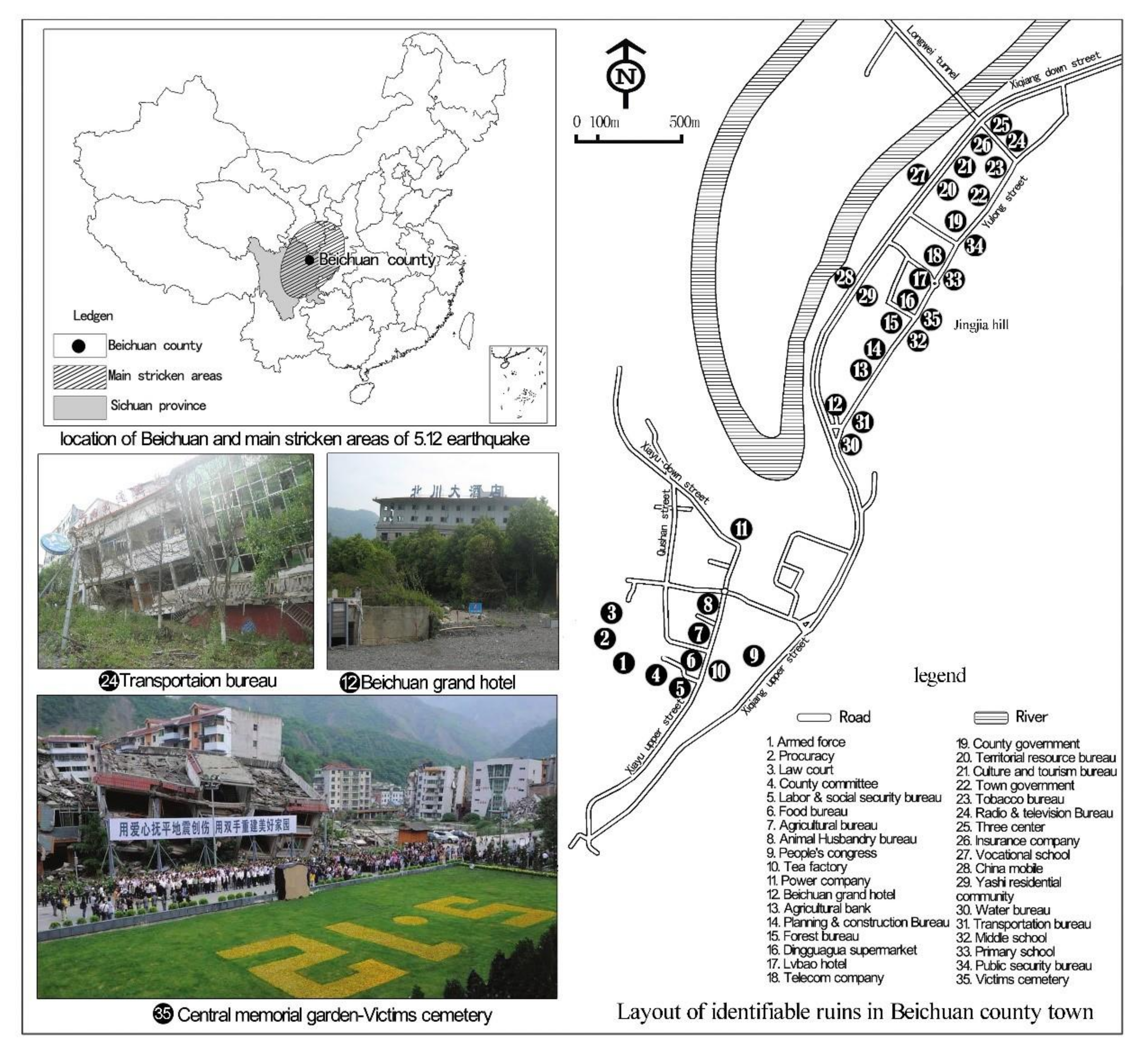
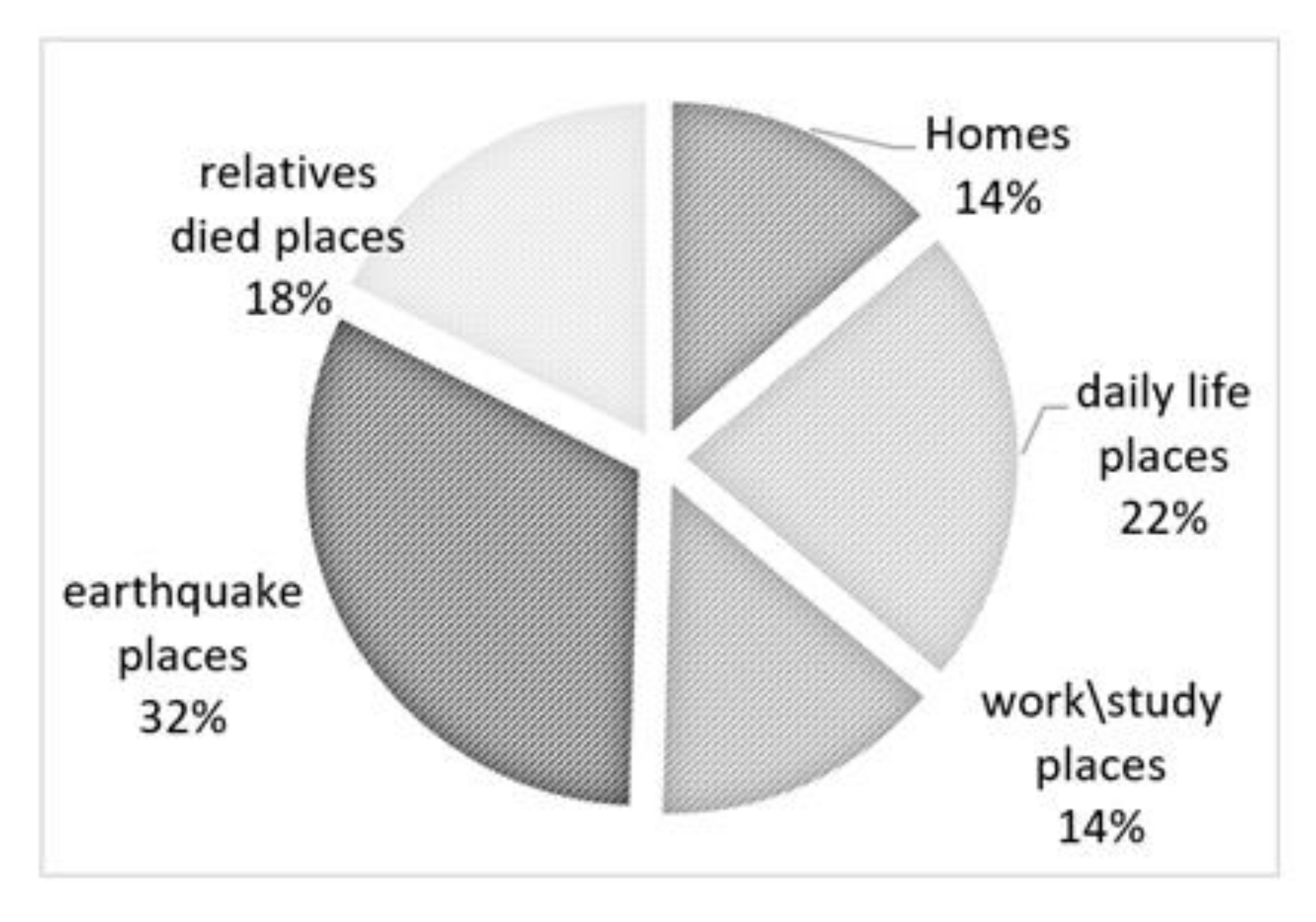
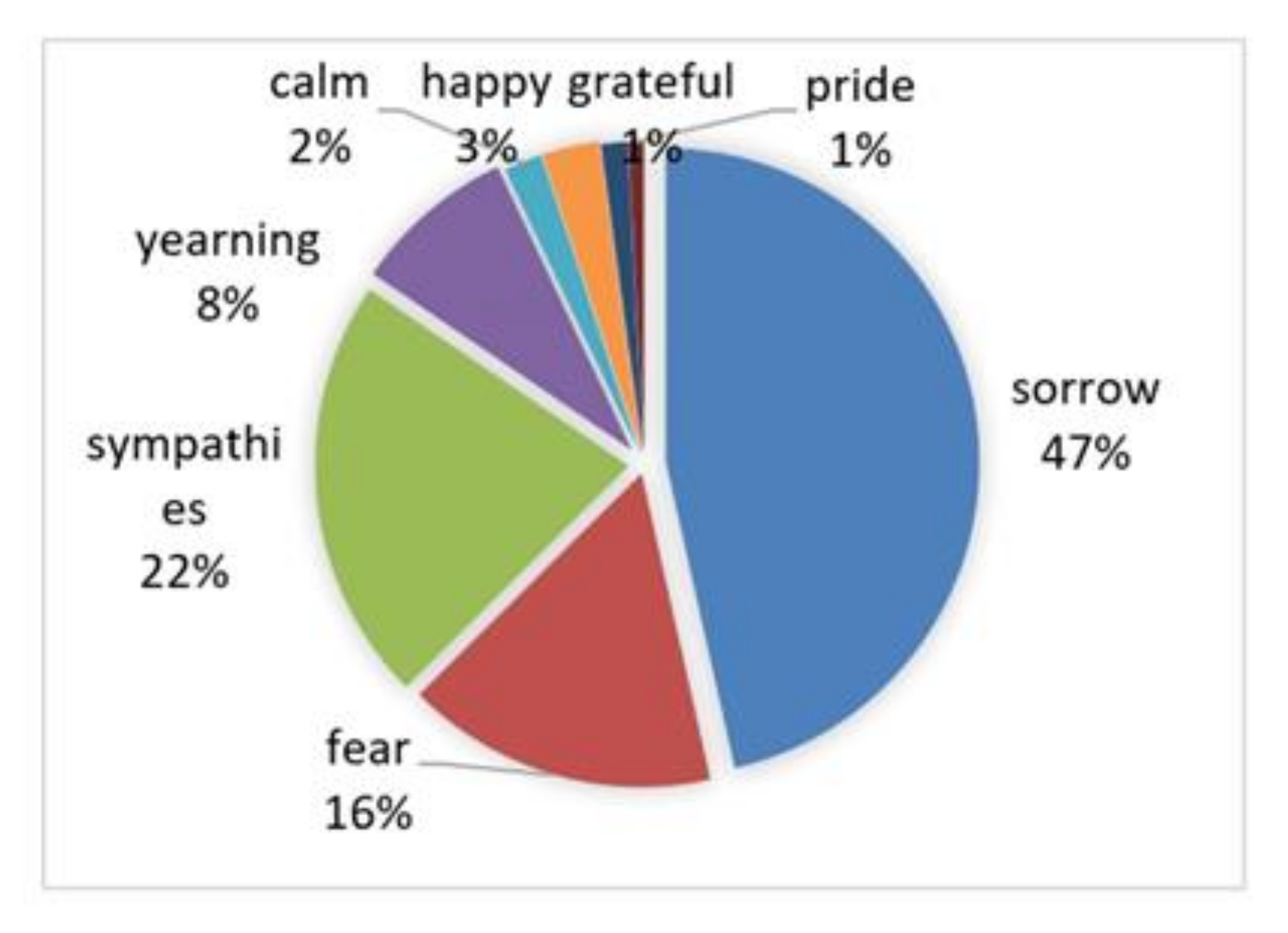
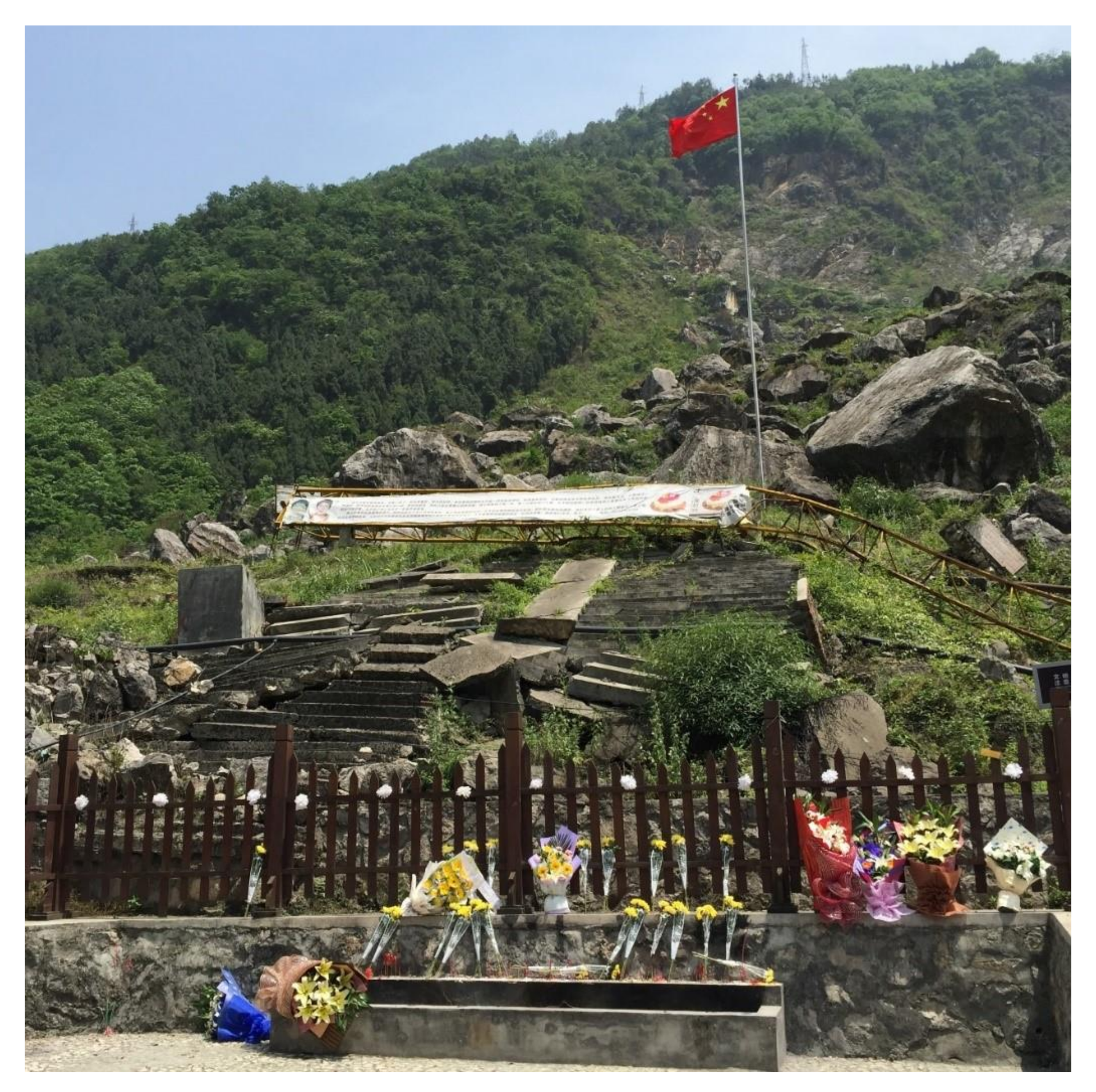
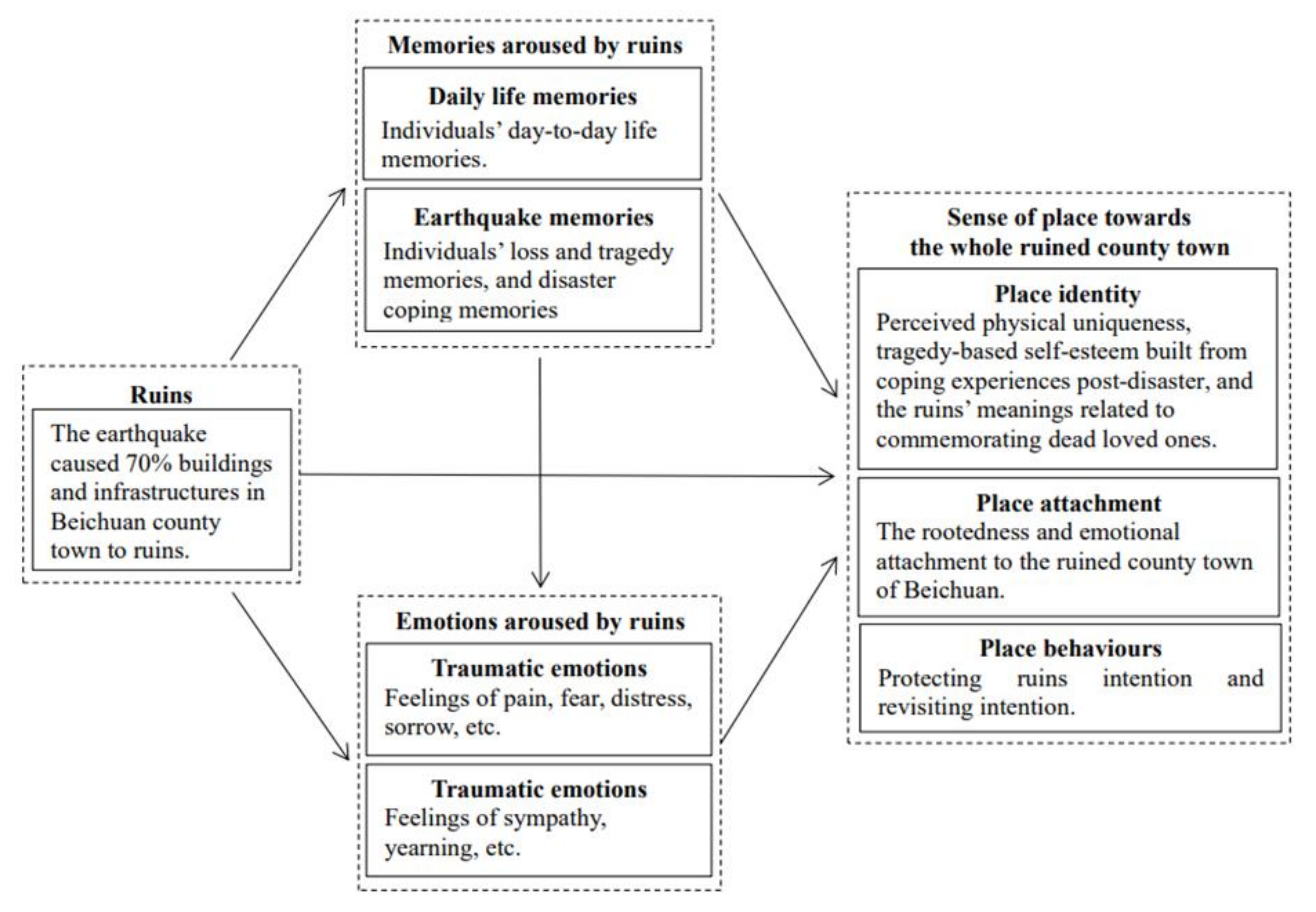
| Sociodemographic Profiles | Frist Survey (N = 191) | Second Survey (N = 321) | |
|---|---|---|---|
| Gender | Male | 84 (44%) | 153 (48%) |
| Female | 107 (56%) | 168 (52%) | |
| Age | Under 20 years old | 5 (2.6%) | 15 (4.7%) |
| 20–39 years old | 90 (47.1%) | 143 (44.5%) | |
| 40–60 years old | 81 (42.4%) | 139 (43.3%) | |
| Over 60 years old | 15 (7.9%) | 24 (7.5%) | |
| Education | Primary school and below | 40 (20.9%) | 62 (19.3%) |
| Junior middle school | 83 (43.5%) | 115 (35.8%) | |
| High school | 46 (24.1%) | 93 (29%) | |
| College and above | 22 (11.5%) | 51 (15.9%) | |
| Length of Residence | Under 5 years | 49 (25.7%) | 71 (22.1%) |
| 5–10 years | 7 (3.7%) | 47 (14.6%) | |
| 11–30 years | 61 (31.9%) | 124 (38.6%) | |
| Over 30 years | 74 (38.7%) | 79 (24.7%) | |
| Relatives died | Died | 126 (66%) | 237 (73.8%) |
| None | 65 (34%) | 84 (26.2%) | |
| Economic loss | None | 8 (4.2%) | 25 (7.8%) |
| Little | 10 (5.2%) | 19 (5.9%) | |
| Moderate | 20 (10.5%) | 62 (19.3%) | |
| Less serious | 30 (15.7%) | 67 (20.9%) | |
| Serious | 123 (64.4%) | 148 (46.1%) | |
| Themes | Sub-Themes | Items | Means | SD |
|---|---|---|---|---|
| Place identity | 4.18 | 0.92 | ||
| Uniqueness | PI1: It is unique to me. | 4.20 | 0.83 | |
| Meanings | PI2: It is meaningful and important to me. | 4.28 | 0.92 | |
| Self-esteem | PI3: It is my spiritual sustenance. | 4.09 | 0.90 | |
| Place attachment | 4.30 | 0.91 | ||
| Rootedness | PA1: My root is in it. | 4.14 | 0.86 | |
| Attachment | PA2: I have a deep attachment to it. | 4.46 | 0.87 | |
| Place behaviors | 4.33 | 0.67 | ||
| Protection | PPI1: I hope it will be preserved. | 4.66 | 0.91 | |
| intentions | PPI2: I’d like to take part in protection action. | 4.60 | 0.92 | |
| PPI3: I would like to donate money for it. | 4.57 | 0.94 | ||
| Revisit | PR1: I come back often. | 3.92 | 1.09 | |
| PR2: I bring my relatives back often. | 3.88 | 1.13 | ||
| Place Identity | Place Attachment | Place Behaviors | ||||
|---|---|---|---|---|---|---|
| Means | F | Means | F | Means | F | |
| Gender | 0.06 | 0.01 | 0.03 | |||
| Male | 4.20 | 4.30 | 4.33 | |||
| Female | 4.18 | 4.31 | 4.32 | |||
| Age | 11.38 *** | 16.49 *** | 1.61 | |||
| Under 20 years old | 3.04 | 3.00 | 3.96 | |||
| 20–39 years old | 4.11 | 4.19 | 4.33 | |||
| 40–60 years old | 4.33 | 4.50 | 4.36 | |||
| Over 60 years old | 4.57 | 4.67 | 4.38 | |||
| Education | 0.40 | 1.04 | 0.39 | |||
| Primary school and below | 4.29 | 4.48 | 4.29 | |||
| Junior middle school | 4.17 | 4.30 | 4.29 | |||
| High school | 4.13 | 4.25 | 4.27 | |||
| College and above | 4.21 | 4.21 | 4.38 | |||
| Length of Residence | 36.23 *** | 48.64 *** | 12.73 *** | |||
| Under 5 years | 3.38 | 3.40 | 3.98 | |||
| 5–10 years | 3.88 | 4.00 | 4.18 | |||
| 11–30 years | 4.37 | 4.59 | 4.35 | |||
| Over 30 years | 4.82 | 4.90 | 4.69 | |||
| Relatives died | 27.81 *** | 26.66 *** | 13.53 *** | |||
| Died | 4.34 | 4.45 | 4.41 | |||
| None | 3.75 | 3.88 | 4.10 | |||
| Economic loss | 16.03 *** | 24.07 *** | 4.99 ** | |||
| None | 3.17 | 3.22 | 4.13 | |||
| Little | 3.47 | 3.29 | 3.85 | |||
| Moderate | 4.11 | 4.28 | 4.25 | |||
| Less serious | 4.28 | 4.38 | 4.29 | |||
| Serious | 4.44 | 4.59 | 4.47 | |||
Publisher’s Note: MDPI stays neutral with regard to jurisdictional claims in published maps and institutional affiliations. |
© 2021 by the authors. Licensee MDPI, Basel, Switzerland. This article is an open access article distributed under the terms and conditions of the Creative Commons Attribution (CC BY) license (https://creativecommons.org/licenses/by/4.0/).
Share and Cite
Qian, L.; Zheng, C.; Lai, Q.; Guo, J. A County Town in Ruins: Memories, Emotions, and Sense of Place in Post-Earthquake Beichuan, China. Sustainability 2021, 13, 11258. https://doi.org/10.3390/su132011258
Qian L, Zheng C, Lai Q, Guo J. A County Town in Ruins: Memories, Emotions, and Sense of Place in Post-Earthquake Beichuan, China. Sustainability. 2021; 13(20):11258. https://doi.org/10.3390/su132011258
Chicago/Turabian StyleQian, Lili, Chunhui Zheng, Qin Lai, and Juncheng Guo. 2021. "A County Town in Ruins: Memories, Emotions, and Sense of Place in Post-Earthquake Beichuan, China" Sustainability 13, no. 20: 11258. https://doi.org/10.3390/su132011258
APA StyleQian, L., Zheng, C., Lai, Q., & Guo, J. (2021). A County Town in Ruins: Memories, Emotions, and Sense of Place in Post-Earthquake Beichuan, China. Sustainability, 13(20), 11258. https://doi.org/10.3390/su132011258






